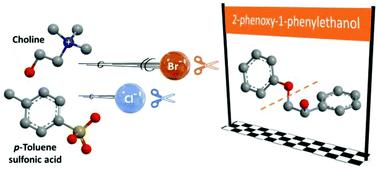当前位置:
X-MOL 学术
›
Green Chem.
›
论文详情
Our official English website, www.x-mol.net, welcomes your feedback! (Note: you will need to create a separate account there.)
Novel insights into biomass delignification with acidic deep eutectic solvents: a mechanistic study of β-O-4 ether bond cleavage and the role of the halide counterion in the catalytic performance
Green Chemistry ( IF 9.8 ) Pub Date : 2020-02-27 , DOI: 10.1039/c9gc02569c André M. da Costa Lopes 1, 2, 3, 4, 5 , José R. B. Gomes 1, 2, 3, 4, 5 , João A. P. Coutinho 1, 2, 3, 4, 5 , Armando J. D. Silvestre 1, 2, 3, 4, 5
Green Chemistry ( IF 9.8 ) Pub Date : 2020-02-27 , DOI: 10.1039/c9gc02569c André M. da Costa Lopes 1, 2, 3, 4, 5 , José R. B. Gomes 1, 2, 3, 4, 5 , João A. P. Coutinho 1, 2, 3, 4, 5 , Armando J. D. Silvestre 1, 2, 3, 4, 5
Affiliation

|
Development of innovative technologies for efficient, yet eco-friendly, biomass delignification is required to achieve higher sustainability than traditional processes. In this context, the use of deep eutectic solvents (DESs) for the delignification process could fulfil these requirements and stands today as a promising alternative. This work focuses on understanding the fundamental chemistry behind the cleavage of the β-O-4 ether bond present in 2-phenoxy-1-phenylethanol (PPE), a lignin model compound, with three acidic DESs, including Propionic acid/Urea (PA : U), Lactic acid/Choline Chloride (LA : ChCl) and p-Toluenesulphonic acid/Choline chloride (pTSA : ChCl). The acidic nature of each DES influenced the efficiency of PPE cleavage and determined the extent of further side reactions of cleavage products. Although PA : U (2 : 1) demonstrated the ability to dissolve lignin, it is unable to cleave β-O-4 ether linkage in PPE. On the other hand, LA : ChCl (10 : 1) allowed PPE cleavage, but an esterification between the PPE and lactic acid as well as oligomerization of lactic acid was detected. Among the examined solvents, pTSA : ChCl (1 : 1) demonstrated the highest performance in the PPE cleavage, although the high acidity of this system led to the condensation of cleavage products with prolonged time. The presence of water decreases the ability of DESs for cleavage, but the extension of undesired side reactions was also reduced. Finally, the analysis of intermediates and products of the reactions allowed the identification of a chlorinated species of PPE that precedes the cleavage reaction. A kinetic study using pTSA : ChCl (1 : 1) and pTSA : ChBr (1 : 1) was performed to unveil the role of the halide counterion present in DESs in the cleavage of the β-O-4 ether bond and a new reaction mechanism was herein proposed and supported by density functional theory (DFT) calculations.
中文翻译:

酸性深共熔溶剂对生物质脱木素作用的新见解:β-O-4醚键断裂的机理研究以及卤化物抗衡离子在催化性能中的作用
为了实现比传统工艺更高的可持续性,需要开发创新技术以实现高效而环保的生物质脱木素。在这种情况下,在脱木素过程中使用深共熔溶剂(DES)可以满足这些要求,并且今天已成为有希望的替代方法。这项工作的重点是理解木质素模型化合物2-苯氧基-1-苯基乙醇(PPE)中的β-O-4醚键与三种酸性DES(包括丙酸/尿素(PA))裂解后的基本化学原理。 :U),乳酸/氯化胆碱(LA:ChCl)和对甲苯磺酸/氯化胆碱(pTSA:ChCl)。每个DES的酸性都影响PPE裂解的效率,并决定了裂解产物进一步副反应的程度。尽管PA:U(2:1)表现出溶解木质素的能力,但它无法裂解PPE中的β-O-4醚键。另一方面,LA∶ChCl(10∶1)允许PPE裂解,但是检测到PPE与乳酸之间的酯化以及乳酸的低聚。在检查的溶剂中,pTSA:ChCl(1:1)在PPE裂解中表现出最高的性能,尽管该系统的高酸度导致裂解产物的缩合时间延长。水的存在降低了DES裂解的能力,但是不期望的副反应的扩展也减少了。最后,对反应的中间体和产物的分析允许鉴定在裂解反应之前的PPE的氯化物。进行了使用p TSA:ChCl(1:1)和p TSA:ChBr(1:1)的动力学研究,以揭示存在于DES中的卤化物抗衡离子在β-O-4醚键和a的裂解中的作用。本文提出了新的反应机理,并得到密度泛函理论(DFT)计算的支持。
更新日期:2020-02-27
中文翻译:

酸性深共熔溶剂对生物质脱木素作用的新见解:β-O-4醚键断裂的机理研究以及卤化物抗衡离子在催化性能中的作用
为了实现比传统工艺更高的可持续性,需要开发创新技术以实现高效而环保的生物质脱木素。在这种情况下,在脱木素过程中使用深共熔溶剂(DES)可以满足这些要求,并且今天已成为有希望的替代方法。这项工作的重点是理解木质素模型化合物2-苯氧基-1-苯基乙醇(PPE)中的β-O-4醚键与三种酸性DES(包括丙酸/尿素(PA))裂解后的基本化学原理。 :U),乳酸/氯化胆碱(LA:ChCl)和对甲苯磺酸/氯化胆碱(pTSA:ChCl)。每个DES的酸性都影响PPE裂解的效率,并决定了裂解产物进一步副反应的程度。尽管PA:U(2:1)表现出溶解木质素的能力,但它无法裂解PPE中的β-O-4醚键。另一方面,LA∶ChCl(10∶1)允许PPE裂解,但是检测到PPE与乳酸之间的酯化以及乳酸的低聚。在检查的溶剂中,pTSA:ChCl(1:1)在PPE裂解中表现出最高的性能,尽管该系统的高酸度导致裂解产物的缩合时间延长。水的存在降低了DES裂解的能力,但是不期望的副反应的扩展也减少了。最后,对反应的中间体和产物的分析允许鉴定在裂解反应之前的PPE的氯化物。进行了使用p TSA:ChCl(1:1)和p TSA:ChBr(1:1)的动力学研究,以揭示存在于DES中的卤化物抗衡离子在β-O-4醚键和a的裂解中的作用。本文提出了新的反应机理,并得到密度泛函理论(DFT)计算的支持。

























 京公网安备 11010802027423号
京公网安备 11010802027423号